Is Sacramento’s Cesar Chavez Plaza primed for resurgence? Some say the time is now
Nearly six years ago, Sacramento restaurateur Ernesto Delgado made a gamble.
He opened the Mexican eatery La Cosecha in the Cesar Chavez Plaza, a public space long regarded as a civic failure. Named after labor leader Cesar Chavez, who is honored on March 31 with a holiday on his birthday, the troubled park cries out for efforts to improve it.
Delgado wants to do that and he has goals of changing its reputation. He envisions families having lunch on the lawns of the park and couples strolling past the fountain at night. A space suitable, and worthy, of the city’s ever-growing Latino population.
For a brief time, after decades of failed efforts, the revival seemed possible. Downtown was beginning to click with its new arena for the Sacramento Kings, new hotels and housing.
Then, the pandemic arrived. Businesses closed and employers and employees turned to remote work. The city’s homeless crisis, like that in much of the nation, worsened. When people did eventually return, they did so to protest or mourn, because of rising racial tension and political conflict.
Delgado took those punches, as he puts it, for the last three years. Now, he’s doubling down on his gamble.
Later this year, he will open another restaurant across the street from the plaza. He’s holding monthly meetings at La Cosecha, determined to involve city and community leaders to create sustainable change in the area.
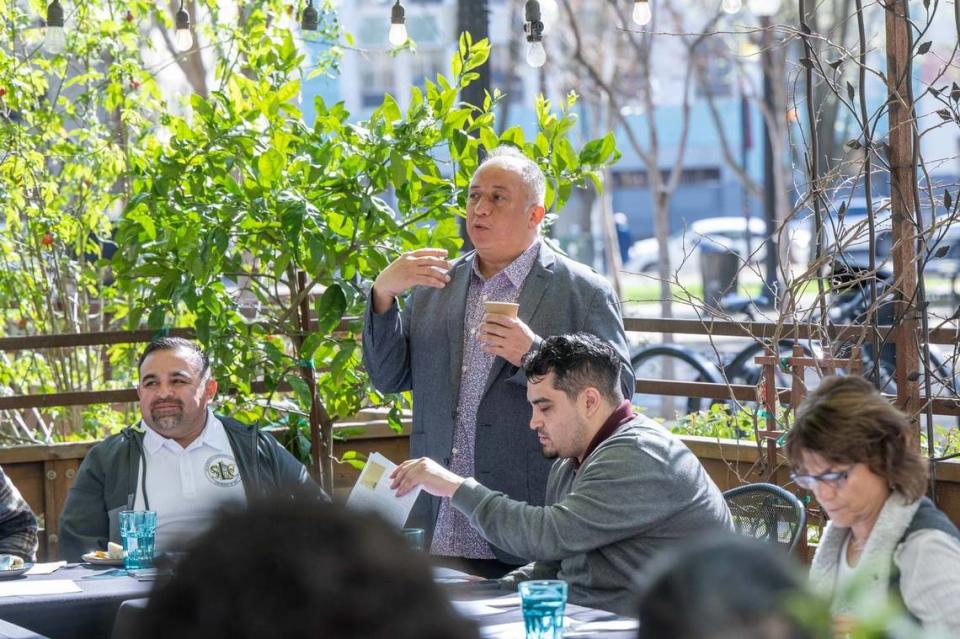
His visions have become even larger since taking over a previous eatery space in 2017.
At a community meeting in late January, Delgado stood near the granite bar top of his restaurant and greeted people as they entered with coffee and pan dulce (sweet bread). Delgado, who is 52 with thinning gray hair and an enthusiastic face, peppers them with questions and grand ideas.
He points to the now-abandoned Sacramento Federal Building, which is about 700 feet from the restaurant.
“I see this beautiful building, across the street and not being used. How about we convert that into a Latino hotel?” Delgado asks a nearby person.
Delgado constantly looks out of his restaurant and dreams about what it can become. What he sees now is an empty park, two-and-a half acres at 9th and I streets, across from city hall and down the street from the main jail.
The plaza is a centerpiece to downtown, yet a daily eyesore. And there’s an argument this plaza might never change. With the exception of a few days a week, for a few months each year, the plaza is largely empty. Its reputation hasn’t changed for decades.
State workers are still primarily using remote work. And, most notably, the number of people living on the street has tripled in Sacramento since 2017. On any given day, the housing crisis, mental health crisis and drug epidemic lands on the doorsteps of Delgado’s restaurant and the plaza.
Still, Delgado believes Cesar Chavez Plaza can have a renaissance and become a hub of community. History says otherwise.
“You have to be a little bit crazy to believe that you can make change, and I can’t expect it to happen overnight,” Delgado said. “The fact that La Cosecha is still open is a sign that it can happen.”
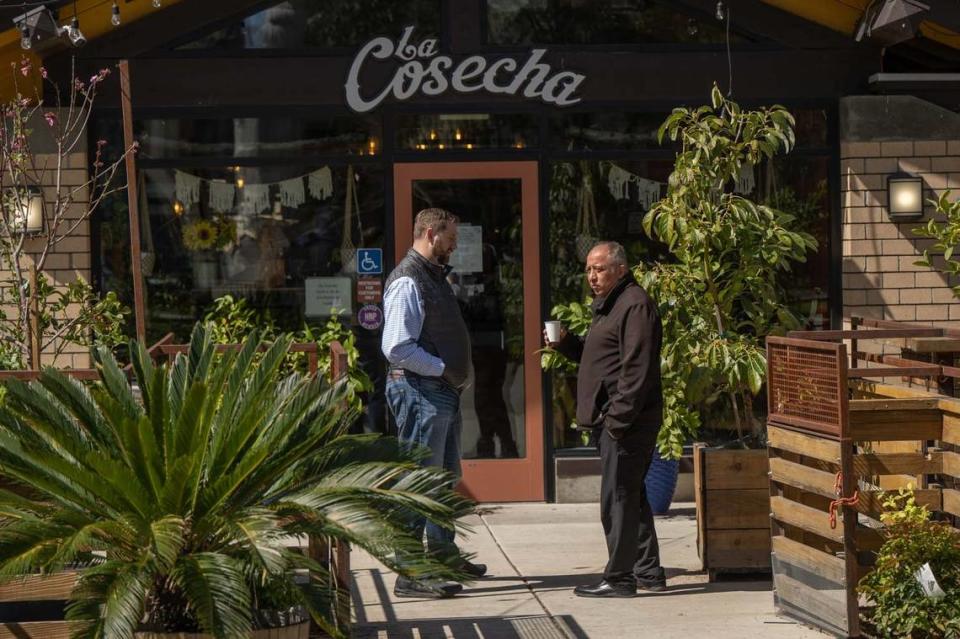
A Latino legacy at the plaza
What is now Cesar Chavez Plaza was once named Old City Plaza and founded in 1849 by John Sutter.
Following Chavez’s death in 1993, Sacramento’s first Latino mayor, Joe Serna Jr. began pushing for initiatives to honor the civil rights leader who had a lifelong connection with the city.
Cesar Chavez’s relationship with Sacramento began when he was a 14-year old migrant picking canary tomatoes with his family in the Sacramento Delta in the early 1940s, according to Marc Grossman, Chavez’s longtime spokesman and personal aide.
Chavez was drawn back to Sacramento years later at the end of the historic 1966 march from Delano. The state Capitol was also the scene of several marches that followed over the next few decades.
Grossman recalled Serna Jr., a son of migrant farmworkers, saying that Chavez was the first person to make him proud to be Mexican.
“Joe traced his activism as a Chicano to him,” Grossman said.
In 1997, the plaza was renamed as part of City Council resolution. Serna died in 1999 but two years later on April 23, 2001, the anniversary of Cesar Chavez’s death, a sculpture commemorating the 1966 march was unveiled in the plaza.
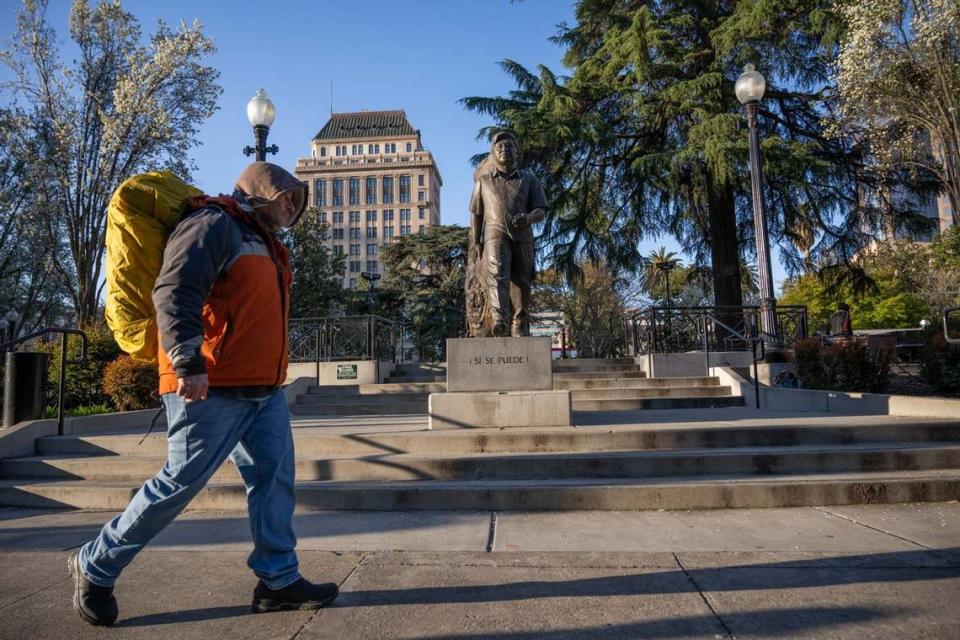
Delgado wants to expand on that legacy and lean more into its Latino culture. He strives to create a mini-version of the famed Zocalo in Mexico City. One of the largest public places in the world, the plaza is a centerpiece of community gatherings.
But the Zocalo is not unique. Rare is a city, village or town in Latin America without a plaza.
“The plazas are everywhere and they create community,” Delgado said.
The open spaces stem from a Spanish royal decree, the Law of the Indies, in the 16th Century. It stated all towns should be centered on a plaza surrounded by prominent church and government buildings. Today, even the smallest town has a plaza in Latin America, according to Paavo Monkkonen, a professor of urban planning and public policy at the UCLA.
“The cultural significance is big. It’s the center of city, in theory, so it’s got a very useful function as a social function as well as a landmark meeting place,” said Monkkonen.
‘Everyone unloads there problem here’
Despite its history, Cesar Chavez Plaza has been at the center of Sacramento’s homeless crisis for decades.
The Sacramento County Main Jail, two blocks away, is likely one of the main reasons why. The facility processes inmates from cities — Roseville, Citrus Heights, Folsom and Rancho Cordova — across the county.
On any given day, multiple people are released from the jail, without any resources, and make their way to the plaza. The jail averaged roughly between 64 to 66 inmate releases per day over the last two years, according to the Sacramento Sheriff’s Office.
“Everyone unloads their problem here,” said Sacramento councilman Eric Guerra.
Guerra specifically highlighted a statewide lack of mental health services, a particularly prevalent issue in jails and prisons. In 2017, 42% of the total Sacramento County inmate population was receiving some level of mental health services.
“Is it fair that someone who gets arrested in Citrus Heights gets sent to downtown Sacramento?” Guerra said.
The area also lacks shelter beds.
The city has roughly 1,700 available shelter beds, according to Sacramento Steps Forward. As of 2022, about 9,278 individuals experience homelessness in Sacramento County, according to the federally-mandated point-in-time homeless count.
In 2009, when Armando began his all-volunteer based group, C.A.F.F.E. or Clothing and Food For Everyone, the homeless population was at about 2,800 and decreasing.
Since then, Armando Flores has shown up to the plaza each Sunday morning to provide food and clothing. He said the inspiration came from driving around town and seeing people on the street during the winter.
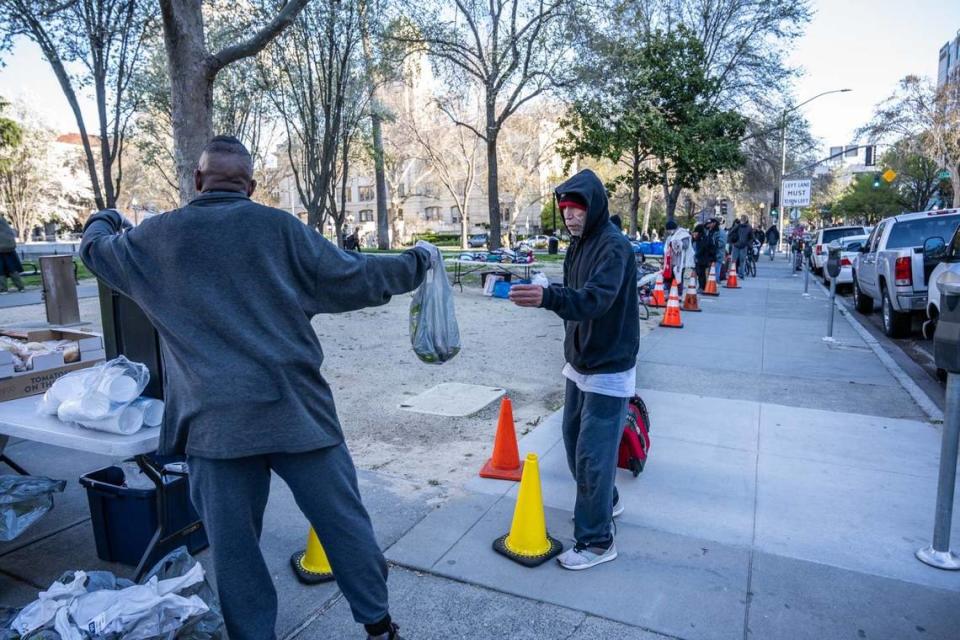
For a brief period, Flores drove around the city offering coffee. That soon evolved to serving food, and then came the need for a central location. For its convenience and locality, Flores chose the plaza.
“We were just driving around trying to find them on the streets, so it was a little more difficult than what we do right now,” Flores said.
Back then, Flores said, the group would feed about 20 people every week. Today, meal gatherings can draw between 150 to 250 people.
Flores said he believes the meal gatherings have not led to a larger congregation of the unhoused at the plaza. He attributed that to the general steady increase in homeless population over the last decade.
But Flores does recognize the disconnect between the unhoused population and Sacramento families. He understands why this is the “only park in Sacramento where people don’t come to cook or hangout.”
“It creates a little bit of fear for the regular community member who wants to cross through the park or come to the restaurant,” Flores said.
He pushed for more education, so that community members can know better how to interact with an unhoused person and realize they likely won’t cause harm. Flores also encouraged more investment into community activities to keep the unhoused population busy and perhaps less congregated at the plaza.
“These people are inclusive in the neighborhood,” Flores said. “They’re not going away.”
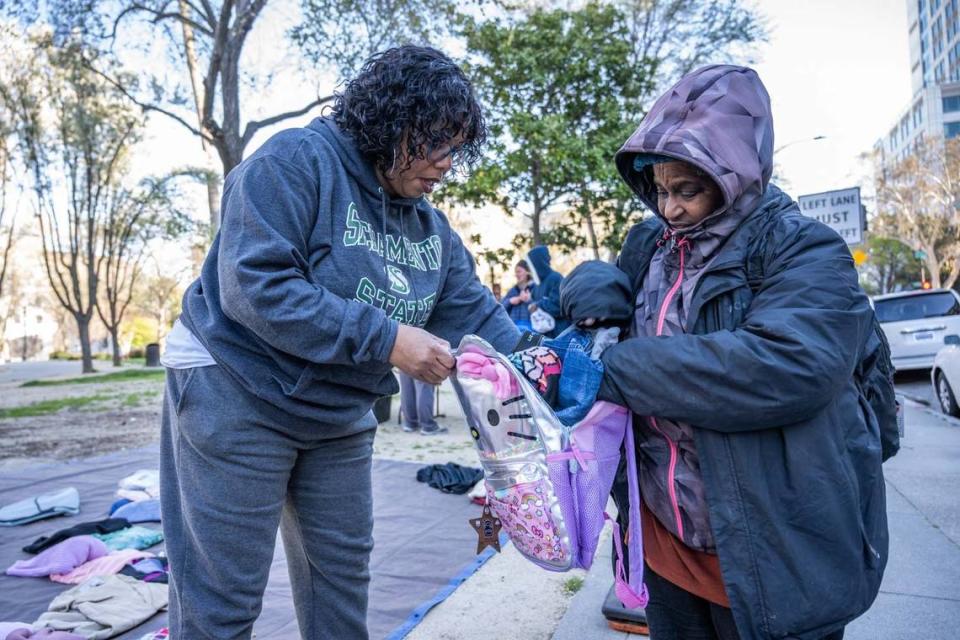
What’s going to change?
Over the years, Sacramento has spent thousands of dollars on landscaping and other renovations. Most notably, a $360,000 “Portland Loo” style restroom in 2019.
However, by most estimates, the plaza remains the same except for Thursday Farmer’s Markets and Friday Nights In The Park, the longest-running, outdoor music festival in the city. Both events are seasonal.
The area particularly suffered from a lack of foot traffic because of the COVID-19 pandemic.
At the CalEPA building, across the street from the plaza, only 12 to 15% of staff are coming into the building based on a 30-day average. Department leaders continue to assess remote work arrangements and there is no projected date for when employees will return to primarily in-person work, according to CalEPA information officer Kalin Kipling-Mojaddedi.
City officials and business interests agree that more buy-in is needed at all levels for sustainable change.
“Everyone needs to have a stake in the game,” Guerra said.
Recently, some headway has been made.
Delgado’s monthly community meetings at La Cosecha have garnered an array of attendees — Sacramento City Council members, Downtown Sacramento Partnership, Consulate of Mexico, Mexican Cultural Center, Sacramento Lowrider Commission and C.A.F.F.E. Near the end of last year, the group facilitated screenings of classic Mexican films during “Family Days” at the plaza.
At last month’s meeting, a SMUD Shine grant for $29,000 in funding was announced. Downtown Sacramento Partnership willmatch 50% of the money for a total of $44,000. Funding will be directed toward flexible infrastructure like mobile book carts, large building blocks, chairs, umbrellas tables and lawn games.
“Hopefully it’s successful enough that we can identify other funding sources to continue to build upon it,” said Scott Ford, economic development director for Downtown Sacramento Partnership.
A new housing community a block away from the plaza is arriving soon. The project, called “Envoy,” is comprised of 153 rental homes, plus a three-story concrete retail, office and parking structure. The project is expected to open in May, according to Riaan DeBeer, vice president of development of Anthem Properties.
DeBeer referenced a key principle of urban design known as crime prevention through environmental design or CPTED. The idea is to bring people to live into the neighborhood and create a sense of safety and comfort.
That’s the progress that has eluded the area for some time.
“It just changes the whole dynamic, and all of a sudden it’s a positive space to be in,” DeBeer said.
DeBeer said the goal is not to push out the homeless population, but to create a mix of people who are economically active and residing permanently in the area.
“They’re not the problem,” DeBeer said. “They need help, and they need support. But the problem is that we’re not actually encouraging people to live in the downtown at the moment.”
Earlier this month, Delgado stood outside La Cosecha, just a few steps from where he placed large red letters that spelled out “Amor,” which means love in Spanish. There, he discussed the struggles of the last six years with a Downtown Sacramento Partnership guide.
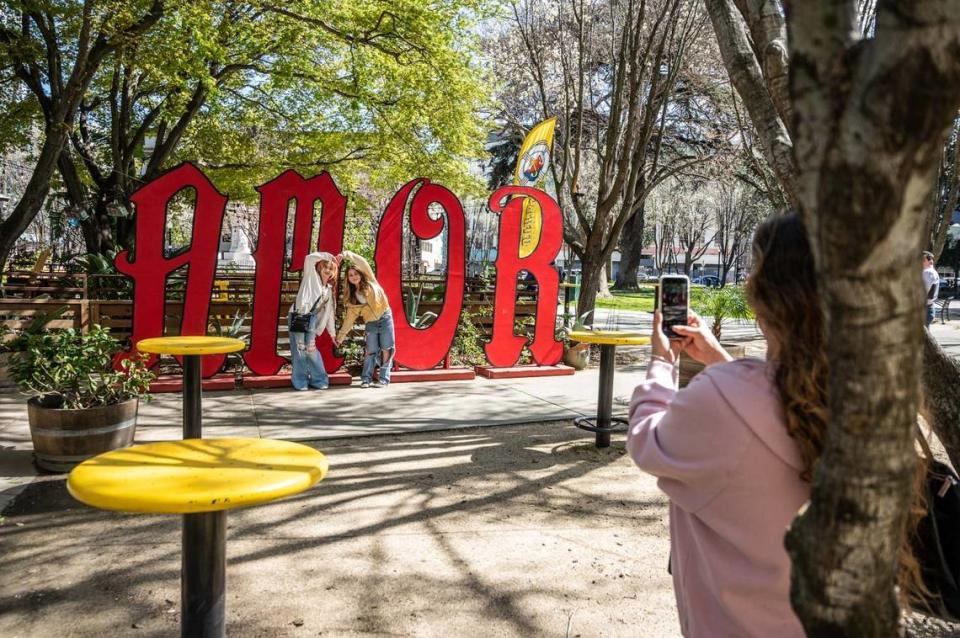
Delgado and his employees have seen it all — people smoking of methamphetamine near the fountain, feces on the restaurant doorsteps, the smell of urine on the back fence and a polite man asking for a cup of water.
He has dealt with it all here, and in a few months will face those same challenges at a second restaurant location. But he says it’s never been his plan to fix the homeless crisis. His goal to beautify the plaza to such a point that it can no longer be ignored.
“We need to come here,” Delgado said. “We need to sit there aunque hay (even though there’s) unhoused that’s the only way that we’re going to change this.”

